-
Membership
Membership
Anyone with an interest in the history of the built environment is welcome to join the Society of Architectural Historians -
Conferences
Conferences
SAH Annual International Conferences bring members together for scholarly exchange and networking -
Publications
Publications
Through print and digital publications, SAH documents the history of the built environment and disseminates scholarshipLatest Issue:

-
Programs
Programs
SAH promotes meaningful engagement with the history of the built environment through its programsMember Programs
-
Jobs & Opportunities
Jobs & Opportunities
SAH provides resources, fellowships, and grants to help further your career and professional life -
Support
Support
We invite you to support the educational mission of SAH by making a gift, becoming a member, or volunteering -
About
About
SAH promotes the study, interpretation, and conservation of the built environment worldwide for the benefit of all
Cuba: Day 12 - Santiago de Cuba
They say there is a big rivalry between Santiago and Havana, and habaneros would most likely dismiss Santiago as the second city, the second to Havana in population, and second in everything else, including baseball! It didn’t take long for me determine that Santiago was one of the three in my “Top 3” list, and I wouldn’t say that Santiago is second to anything. A vibrant, beautiful city, Santiago is often characterized as the most Caribbean of Cuba’s cities, partly due to its size and location, which over time have attracted immigrants from other Caribbean islands. We had now visited all of seven settlements of Diego Velázquez!
We started our day at the Office of the City Conservator where the City Conservator, Omar López Rodríguez, gave us an introductory presentation of the history of Santiago and current efforts of the Conservator’s Office. With the new knowledge we were well equipped to head out and experience the city.
Our first stop was Parque Céspedes (Céspedes Park), formerly the Plaza de Armas. This has to be one of the most intriguing squares I have ever visited in my life. Within the four sides of the square one can find architecture from all periods and in various styles. Likewise, the square is interesting in that it is the seat of religious power and civil power in the city as it houses the main church and city hall. We first visited the Casa de Don Diego de Velázquez, which makes the claim of being the oldest house in Cuba and now functions as a museum of living. Though the house has surely undergone many renovations and additions, colonial characteristics of the structure still predominate, from 16th century details to the 19th century mediopuntos (stained glass arched windows found above windows or doors). Here Omar expounded upon some of the traditional building techniques used in Santiago to deal with the seismic activity as the city is located on the same tectonic plates as Haiti (though this system of building is not used exclusively throughout the Velázquez house). A system of woven sticks of various sizes, packed with hay, rocks, clay, and other material, is then plastered, which creates strong walls that are flexible enough to give with seismic activity, rather than collapse.
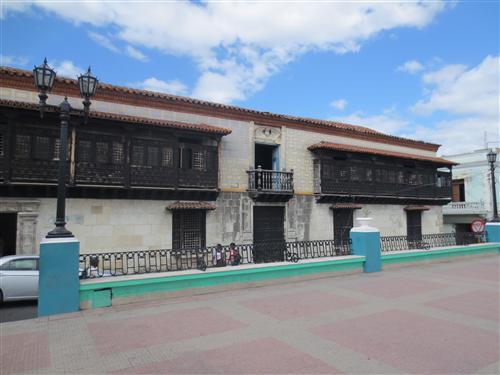
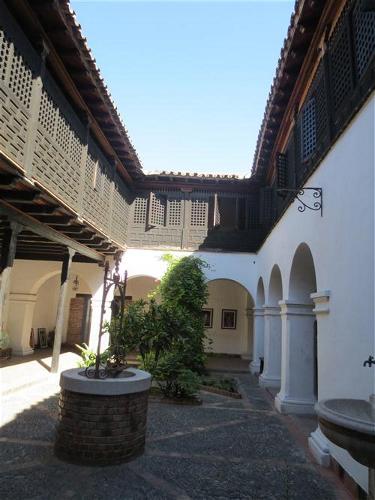
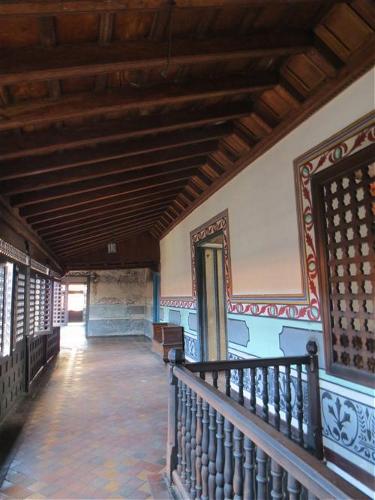
Within the square we also admired el Ayuntamiento (City Hall), which despite its appearance, dates to the 1950s. Its older appearance is due to the fact that though built in the 20th century, the designs for this building date to the 18th century.
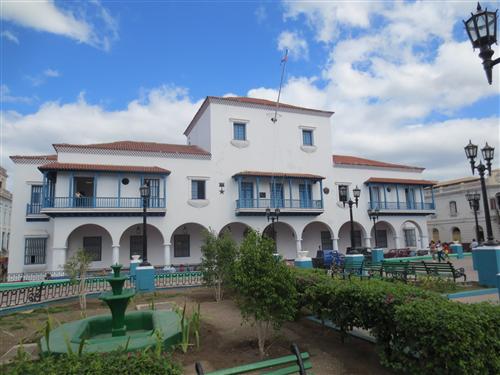
The City Hall is an interesting counterpoint to the Banco Nacional de Cuba (National Bank), as the two were built contemporaneously. Designed by Enrique Luis Varela, this bank represents Santiago’s position as Cuba’s second major financial center.

As we walked up one of the streets that leads out of the square we stopped for a moment in an 18th century building that now serves as headquarters for Santiago’s branch of the Unión Nacional de Escritores y Artistas Cubanos (National Union of Cuban Writers and Artists). We rested for a moment in the courtyard while Omar explained traditional systems of water collection in Santiago. Unlike other cities, like Camagüey, where water is collected and stored in large tinajones, or jugs, it was more common in Santiago for water to be collected from the roof and run through a series of pipes to el aljibe, the cistern. This house had a large cistern, the size of the patio in fact, that was 8 meters deep. Because most of the yearly rain comes all at once in Santiago, large containers are needed to hold the water that must last throughout the year.
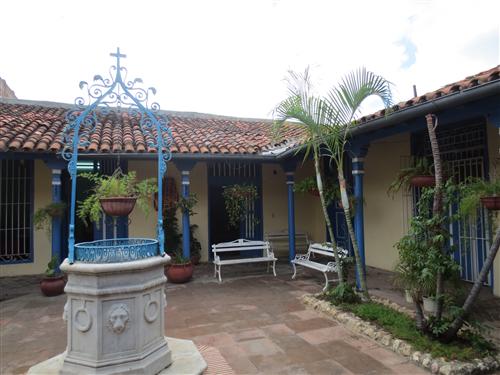
We hopped on the bus to another part of town to see the Moncada Barracks. Built in the 1930s there is an Art Deco feel to this structure, though this structure is more famous for the attack upon it made by Fidel Castro and 72 rebels on July 26, 1953. The bullet holes are still apparent, maintained in this state so that all can remember the first actions of the revolution.
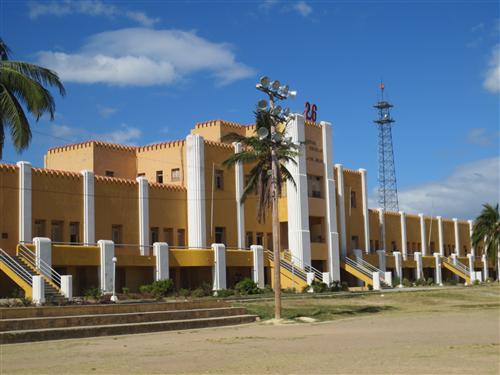
Equally interesting are the surrounding structures, officers’ housing made out of wood, which Monty states were reportedly prefabricated in Mississippi and exported to Santiago. Though we often noted similarities between Cuban architecture and that of the Gulf States, particularly New Orleans, it was often in reference to pre-20th century structures. This was an interesting example of how this relationship continued into the 20th century.
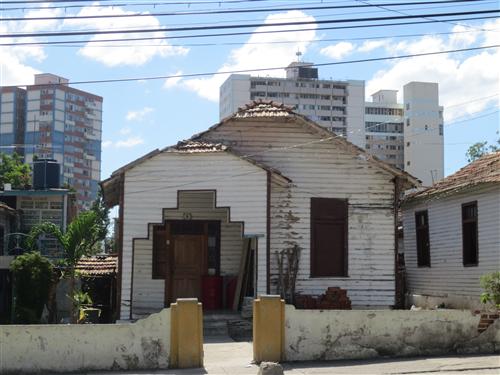
Our day continued in the neighborhood of Vista Alegre, a neighborhood developed for the well-to-do of Santiago. The architect of this urban planning created 15 by 45 meter plots, though many families bought all of the lots within one block to have more space. The original owner of the first house we visited, Casa de Don Pepe Bosch, was an immigrant from Catalan who worked with an engineer to create the company that was responsible for electrifying the neighborhood and for laying the tracks for the trolley in the city.
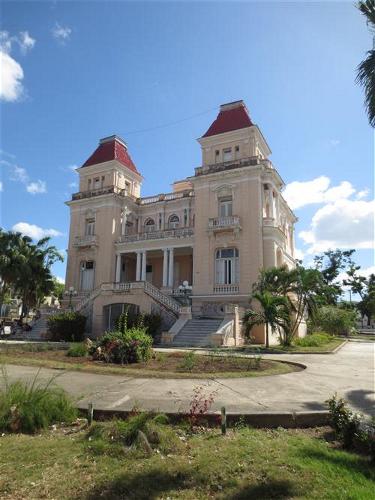
We then visited the University of Oriente Rectorate (1956) by Eduardo Cañas and Nujim Nepomeche. This huge structure is split into two sections of room by an impressive winding staircase that has beautiful terrazzo floors on the ground level. The left side of the stairwell supports more public functions, and contains the cafeteria and theater. The right side of the stairwell in composed of offices.
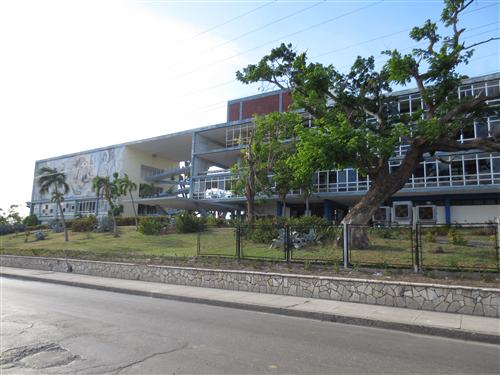
One of our last visits of the day was to the José Martí Housing Complex (1964-1967). The Soviet Union donated a factory, located in Santiago, to produce prefabricated building components to Cuba in 1964. The factory produced pieces for the “Gran Panel” system, which has been used throughout the country, though the Martí Housing Complex is an impressive example and considered to be one of the more successful examples of the “Gran Panel” system. Omar explained how the components were brought to the site, and how they have grooves that are used to fit the pieces together. Many of the types of component pieces are very transparent, essentially walls that are decorative screens. It was particularly interesting to see how the inhabitants have transformed these screens over time, many filling in the openings for more privacy and security, but probably at the price of letting in cooling breezes.
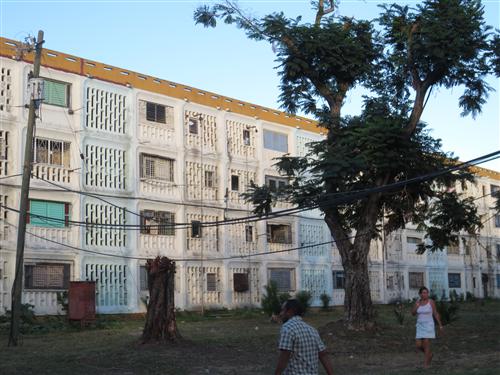
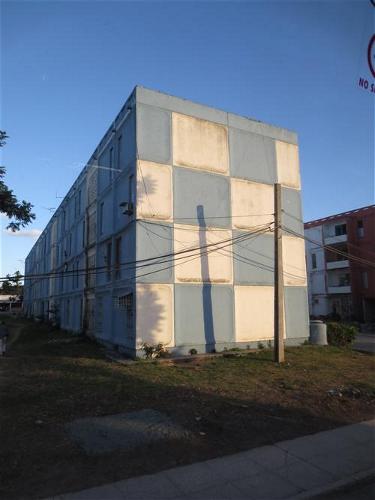
I should also note that during out visit to Santiago we became very aware of the devastating effects Hurricane Sandy had on the city. Already faced with many challenges in restoring and preserving a city full of so many historical buildings, the Office of the City Conservator is now presented with even more projects in the wake of the storm. Omar provided us with some numbers to give us an idea of what the city had to recover from: more than 15,000 structural collapses and more that 30% of the city’s trees were lost. We witnessed this as we traveled throughout the city as well as seeing many positive images of the cleanup and rebuilding efforts that are already in action.
 Erica N. Morawski, Ph.D. Candidate, University of Illinois - Chicago
Erica N. Morawski, Ph.D. Candidate, University of Illinois - Chicago
Erica N. Morawski is a Ph.D. candidate in art History at the University of Illinois – Chicago. She received a BA in art history at Tulane University and MA in Art History at the University of Texas at Austin. She is currently completing a dissertation entitled, “Designing Destinations: Hotel Architecture, Urbanism, and American Tourism in Puerto Rico and Cuba.” This work investigates the role of hotels in shaping understandings of national identity, which in turn shaped international relationships, through an approach that systematically ties object and image analysis with social, political, and economic histories. Her work argues that these hotels functioned, and continue to function, like diplomatic cultural attachés—their design shaped politics on the islands, and played a decisive role in shaping past and current international relations.


Leave a commentOrder by
Newest on top Oldest on top